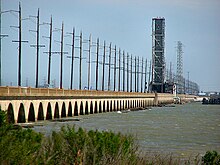Galveston Causeway
| George & Cynthia Mitchell Memorial Causeway | |
|---|---|

The old 1912 Galveston Causeway, now in use as a railroad bridge.
|
|
| Coordinates | 29°17′45″N 94°53′10″W / 29.2957934°N 94.8861265°WCoordinates: 29°17′45″N 94°53′10″W / 29.2957934°N 94.8861265°W |
| Carries | Rail (old causeway) |
| Crosses | Gulf Intracoastal Waterway, Galveston Bay |
| Locale | Galveston |
| Official name | George & Cynthia Mitchell Memorial Causeway |
| Maintained by | Texas Department of Transportation |
| History | |
| Opened | 1912 (original causeway) |
| Statistics | |
| Toll | free both ways |
The George & Cynthia Mitchell Memorial Causeway is a set of causeways in Galveston, Texas, United States. Two of the routes carry the southbound and northbound traffic of Interstate 45, while the original causeway is restricted to rail traffic. It is the main roadway access point to Galveston Island. The second access point is Bolivar Ferry.
The causeway carries traffic over Galveston Bay and the Gulf Intracoastal Waterway. The original causeway was built in 1912 and carried both rail and auto traffic. The auto traffic was transferred to new causeways built to the west in 1939, leaving the original bridge for rail traffic. The original route was listed on the National Register of Historic Places in 1976.
Construction of replacement bridges for both auto routes began in 2003 with completion of the new northbound bridge in 2005. The construction of a new southbound bridge began in 2006, however Hurricane Ike delayed completion until November 2008.
In September 2008, the causeway flooded well before Hurricane Ike, due to the tremendous storm surge created by the very wide storm. This is in contrast to a typical hurricane, which would cause the closure of the causeway due to wind before surge. As of the early afternoon on September 13, 12 hours after official landfall, the causeway was blocked by numerous watercraft.
In 2012, the old bascule-type drawbridge on the railroad causeway was removed and replaced with a vertical-lift-type drawbridge, allowing the navigation channel through the draw span to be widened. In 2001, the U.S. Coast Guard had declared the old span's narrow passageway to be a hazard to navigation. It was only 105 feet (32 m) wide, whereas the replacement vertical-lift span allowed the channel to be widened to about 300 feet (91 m). The old bridge was sold to Sonoma-Marin Area Rail Transit to be installed on the Northwestern Pacific Railroad in Petaluma, California to cross the Petaluma River.
...
Wikipedia
